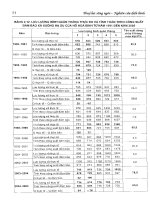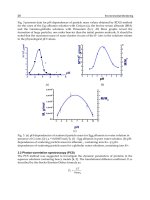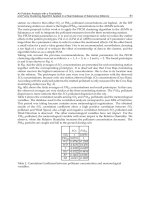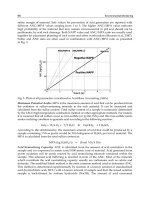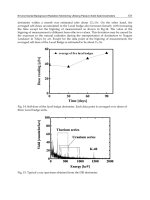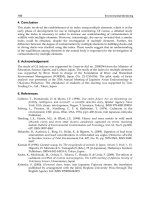Environmental Monitoring Part 3 potx
Bạn đang xem bản rút gọn của tài liệu. Xem và tải ngay bản đầy đủ của tài liệu tại đây (2.16 MB, 35 trang )
Air Pollution Analysis with a Possibilistic and Fuzzy Clustering Algorithm Applied in a Real Database of Salamanca (México) 11
station we observe that either SO
2
or PM
10
pollutant concentrations are highest. At the DIF
monitoring station we observe t he highest PM
10
concentrations in the AEMN network.
The main proposal in this work is to apply the PFCM clustering algorithm to the AEMN in
Salamanca as well to integrate the pollutant measures f r om the three monitoring stations.
The PFCM initial parameters (a, b, m and η) are very important in order to reduce the outlier
effects in the pattern prototypes. Pal et al, i n Pal et al. (2005) recommend of b parameter value
larger than the a parameter value in o r der t o reduce the mentioned effects. On the other hand,
a small value for η and a value greater than 1 for m are recommended. nevertheless, choosing
a too high of a value of m reduces the effect of membership of data to the clusters, and the
algorithm behaves a s a simple PCM.
Taking into account the previous recommendations, the initial parameters for the PFCM
clustering algorithm were set as follows: a
= 1, b = 5, m = 2andη = 2. The found prototypes
( a and b)areshowninFig.4.
In Fig. 4(a) the daily averages of SO
2
concentrations are presented for each monitoring station
together with the corresponding prototypes. It is observed also that Cruz Roja monitoring
station receives the highest emissions of SO
2
concentrations: this is due to its location near
to the refinery. The prototypes in this case were very low in comparison with the observed
SO
2
concentrations, because only one station observed high SO
2
concentrations (Cruz Roja).
According with the analyzed patterns the emitted pollutant is only measured by the Cruz Roja
monitoring station (see Fig. 4).
Fig. 4(b) shows the daily averages of PM
10
concentrations and result prototypes. In this case,
the observed averages are very similar at the three monitoring stations. The PM
10
pollutant
dispersion is more uniform then the SO
2
pollutant dispersion in the city.
Table 2 shows the correlation results among SO
2
and PM
10
pollutants and the meteorological
variables. T he database used in the correlation anal ysis correspond to year 2004 of Nativitas.
This period was taking because contains more meteorological registrations. The obtained
results o f the SO
2
correlation coefficient show a high positive correlation between SO
2
pollutant and Wind Speed, also a high and negative correlation between SO
2
pollutant and
Wind Direction is observed. The other m eteorological variables have not impact. For the
PM
10
pollutant, the meteorological variable with more impact is the Relative Humidity. We
observe, when the Relative Humidity increases the pollutant concentration decreases. The
PM
10
particles are caught and fall to the ground during rain.
SO
2
PM
10
SO
2
1 0.0731
PM
10
0.0731 1
WS 0.4756 -0.1385
WD -0.6151 0.1478
T -0.0329 -0.0007
RH -0.0322 -0.4416
BP 0.1462 0.1806
SR -0.021 -0.1207
Table 2. Correlation Coefficient between pollutant concentration and meteorological
variables.
61
Air Pollution Analysis with a Possibilistic
and Fuzzy Clustering Algorithm Applied in a Real Database of Salamanca (México)
12 Environmental Monitoring
0 5 10 15 20 25 30
0
20
40
60
80
100
120
Number of Days
SO
2
Concentration (ppb)
Comparison among monitoring points and prototype
CR
DF
NA
Prototype
(a) SO
2
0 5 10 15 20 25 30
0
20
40
60
80
100
120
Number of Days
PM
10
Concentration( μ gr/m
3
)
Comparison among monitoring points and prototype
CR
DF
NA
Prototype
(b) PM
10
Fig. 4. Comparison between air pollutant averages and estimated prototypes.
62
Environmental Monitoring
Air Pollution Analysis with a Possibilistic and Fuzzy Clustering Algorithm Applied in a Real Database of Salamanca (México) 13
5. Conclusions
Nowadays, there is a program to improve the air quality in the city of Salamanca, Mexico.
Besides, this program has established thresholds for several levels of contingencies depending
on the SO
2
and PM
10
pollutant concentrations. However, a particular level of contingency for
the city is declared taking into account the highest pollutant concentration provided by one
of the thre e monitoring stations. For example, i f a p ollutant concentration exceeds a given
threshold in a single monitoring station, the alarm of contingency applies to the whole city.
This value is normally provided by the Cruz Roja station, due to its proximity to the refinery
and power generation industries.
Looking for local and general contingency levels in the city, we have proposed to estimate a
set of prototypes such that they can represent a calculated measure of pollutant concentrations
according to the values measured in the three fixed stations. In such a way, a local alarm of
contingency can be activated in the area of impact of the pollution depending on each station,
and a general alarm of contingency according to the values provided by the prototypes.
Nevertheless, the last case requires adjusting the thre sholds, as the actual values would be
only used for l ocal contingency because they depend on the measured values of pollutant
concentrations, and the general contingency requires thresholds as a function of calculated
values.
6. References
Andina, D. & Pham, D. T. (2007). Computational Intelligence,Springer.
Barron-Adame, J. M., Herrera-Delgado, J. A., Cortina-Januchs, M. G., Andina, D. &
Vega-Corona, A. (2007). Air pollutant level estimation applying a self-organizing
neural network, Proceedings of the 2nd international work-conference on Nature Inspired
Problem-Solving Methods in Knowledge Engineering. IWINAC-07, pp. 599–607.
Bezdek, J. C . (1981). Pattern Recognition With Fuzzy Objective Function Algorithms,Kluwer
Academic.
Bezdek, J. C., Keller, J., Krishnapuram, R. & Pal, N. R. (1999). Fuzzy Models and Algorithms for
Pattern Recognition and Image Processing,firstedn,Boston,London.
Celik, M. B. & Kadi, I. (2007). The re lation between meteorological factors and pollutants
concentration in karabuk city, G.U. Journal of science 20(4): 87–95.
Cortina-Januchs, M. G., Barron-Adame, J. M., Vega-Corona, A. & Andina, D. ( 2009). Prevision
of industrial so2 pollutant concentration applying anns, Proceedings of The 7th IEEE
International Conference on Industrial Informatics (INDIN 09), pp. 510–515.
Dunn, J. (1973). A fuzzy relative of the isodata process and its use in detecting compact
well-separated clusters, Journal of Cybernetics 3(3): 32–57.
EPA (2008). Air quality and health, chap ter Environmental Protection A gency, National
Ambient Air Quality Standards (NAAQS).
Fenger, J. (2009). Air pollution in the last 50 years - from local to global, Journal of Atmospheric
Environment 43(1): 13–22.
Hoppener, F., Klawonn, F., Kruse, R. & Runkler, T. (2000). Fuzzy Cluster Analysis, Methods for
classification, data analysis and image recognition, Chistester, United Kingdom.
INE (2004). Programa para mejorar la calidad del aire en S alamanca, 2 edn, Instituto de Ecología del
Estado de Guanajuato, Calle Aldana N.12, Co l. Pueblito de Rocha, 36040 Guanajuato,
Gto.
63
Air Pollution Analysis with a Possibilistic
and Fuzzy Clustering Algorithm Applied in a Real Database of Salamanca (México)
14 Environmental Monitoring
INEGI (2005). National Population and Housing Census 2, National Institute of Geography and
Statistics. www.inegi.org.mx.
Krishnapuram, R. & Keller, J. (1993). A possibilistic approach to clustering, International
Conference on Fuzzy Systems 1(2): 98–110.
Krishnapuram, R. & Keller, J. (1996). The possibilistic c-means algorithm: Insights and
recommendations, International Conference on Fuzzy Systems 4, no 3: 385–393.
Ojeda-Magaña, B., Quintanílla-Dominguez, J., Ruelas, R. & Andina, D. (2009b). Images
sub-segmentation with the pfcm clustering algorithm, Proceedings of The 7th IEEE
International Conference on Industrial Informatics (INDIN 09), pp. 499–503.
Ojeda-Magaña, B., Ruelas, R., Buendía-Buendía, F. & Andina, D. (2009a). A greater knowledge
extraction coded as fuzzy rules and based on the fuzzy and typicality degrees
of the GKPFCM clustering algorithm, In Intelligent Automation and Soft Computing
15(4): 555–571.
Pal, N. R., Pal, S. K. & Bezdek, J. C. (1997). A mixed c-means clustering model, IEEE
International Conference on Fuzzy Systems, Spain, pp. 11–21.
Pal, N. R., Pal, S. K., Keller, J. M. & Bezdek, J. C. (2004). A new hybrid c-means
clustering model., Proceedings of the IEEE International Conference on Fuzzy Systems,
FUZZ-IEEE04, I. Press, Ed.
Pal, N. R., Pal, S. K., Keller, J. M. & Bezdek, J. C. (2005). A possibilitic fuzzy c-means clustering
algorithm, IEEE Transactions on Fuzzy Systems 13(4): 517–530.
Pérez, P., Trier, A. & Reyes, J. (2000). P rediction of pm 2.5 concentrations several hours
in advance using neural networks in santiago, chile, Atmospheric Environment
34(8): 1189–1196.
Ruspini, E. (1970). N umerical method for fuzzz clustering, Information Sciences 2(3): 319–350.
Timm, H., Borgelt, C., Döring, C. & Kruse, R. (2004). An extension to possibilistic fuzzy cluster
analysis, Fuzzy Sets and systems 147, no 1: 3–16.
Timm, H. & Kruse., R. (2002). A modification to improve possibilistic fuzzy cluster analysis.,
Conference Fuzzy Systems, FUZZ-IEEE, Honolulu, HI, USA.
WHO (2008). Air quality and health, chapter World Health Organization.
Zamarripa, A. & Sainez, A. (2007). Medio Ambiente: Caso Salamanca, Instituto de Investigación
Legistativa, H. Congreso del Estado de Guanajuato, LX legislatura.
Zuk, M., Cervantes, M. G. T. & Bracho, L. R. (2007). Tercer almanaque de datos y tendencias de
la calidad del aire en nueve ciudades mexicanas, Technical report, Secretaría de Medio
Ambiente, Recursos Naturales Instituto Nacional de Ecología, México, D.F.
64
Environmental Monitoring
5
Real-Time In Situ Measurements
of Industrial Hazardous Gas
Concentrations and Their Emission Gross
F.Z. Dong et al.
*
Anhui Institute of Optics and Fine Mechanics,
Chinese Academy of Sciences, Science Island, Hefei,
P. R. China
1. Introduction
Over the past few decades environmental protection has been of greatly worldwide
concerns due to the fact of global warming and air quality deterioration particularly in the
fast developing countries like China and India (Platt, 1980; Edner, 1991; Sigrist, 1995;
Culshaw, 1998; Fried, 1998; Linnerud, 1998; Weibring, 1998; Nelson, 2002; Liu, 2002;
Christian, 2003 & 2004; Taslakov, 2006; de Gouw, 2007; Karl, 2007 & 2009;
). These have resulted in large demands and tremendous efforts for
new technology developments to monitor and control industrial gas pollution (Lindinger,
1998; Dong, 2005; Kan, 2006 & 2007; Wang Y.J., 2009; Wang F., 2010; Xia, 2010; Zhang, 2011).
CO
2
, CO, NH
3
, H
2
S, HF, HCI, and volatile organic compounds (VOCs) are very important
gases generated in many industrial processes; therefore to implement on-line monitoring of
these industrial emitted gases is a key factor for industrial process control. Furthermore if
one can simultaneously measure the gas flow path-averaged velocity and gas concentrations
in a smokestack, all the industrial emissions from the targeted smokestack would be real-
time obtained. This could be much beneficial to the administrative implementation of global
environmental protection policy on reduction of gas pollution and environmental
management.
Tunable diode laser absorption spectroscopy (TDLAS) is a kind of technology with advantages
of high sensitivity, high selectivity and fast responsibility. It has been widely used in the
applications of green-house measurements (Feher, 1995; Nadezhdinskii, 1999; Kan, 2006),
hazardous gas leakage detection (May, 1989; Uehara, 1992; Iseki, 2000 & 2004), industry
process control (Linnerud, 1998; Deguchi,2002) and combustion gas measurements (Zhou,
2005; Rieker, 2009). Proton transfer reaction—mass spectrometry (PTR-MS) is a relatively new
technology firstly developed at the University of Innsbruck, Austria, in the 1990s (Hansel,
1995). PTR-MS has been found being an extremely powerful and promising technology for on-
line detection of VOCs at trace level (Smith, 2005; Jordan, 2009). Optical flow sensor (OFS-2000)
based on the concept of optical scintillation to measure airflow velocity (Wang T.I., 1981;
* W.Q. Liu, Y.N. Chu, J.Q. Li, Z.R. Zhang, Y. Wang, T. Pang, B. Wu, G.J. Tu, H. Xia, Y. Yang,
C.Y. Shen, Y.J. Wang, Z.B. Ni and J.G. Liu
Anhui Institute of Optics and Fine Mechanics, Chinese Academy of Sciences, Science Island, Hefei, P. R. China.
Environmental Monitoring
66
), which is first developed by Optical Scientific INC., has
been widely used in the market. OFS-2000 utilizes the high frequency signal of optical
scintillation cross-correlation (OSCC) which is from the fluctuations of temperature or
refractive index. However, OFS-2000 is not applicable when the temperature fluctuation
within the measurement area is small or even ignorable. Recently we have developed a new
kind of optical flow sensor which is based on the low frequency signal of OSCC resulting from
the particle concentration fluctuations. Therefore the newly developed optical flow sensor
could also measure the particle concentration in the stack.
The content of this chapter will first briefly describe the operational principles based on
TDLAS, PTR-MS and OSCC technologies for industrial pollution on-line monitoring. Then
the instruments developed by our group to measure the emission gross will be introduced.
In the third section some experimental results from the field test will be presented. Finally
the discussions and conclusions will be given.
2. Basic operational principles of the instruments
2.1 TDLAS technique
For detecting low concentration gases at atmospheric pressure with TDLAS technique, two-
tone modulations and harmonic detection method are commonly adopted. The diode laser
is modulated with the homemade current and temperature controllers to the wavelength of
1.567μm which precisely locates at the selected absorption line central of target gas CO. The
laser wavelength is scanned through the selected absorption line by a saw-tooth signal at
low frequency of 147Hz and simultaneously modulated by a sinusoidal signal at frequency
of 20 KHz. The modulated laser beam is divided into two parts with a 1×2 fiber splitter. One
arm (20%) is used to go through a 10cm calibration cell as a reference signal, while the other
arm (80%) is used to measure the flue gas concentrations. Two transmitted laser beams are
collimated and then collected by two coincident InGaAs photodiodes after passing through
absorption gases, respectively. These two current signals are then transmitted into the
digital control module (DCM) to gain the harmonic signals. At last, these signals are sent to
computer for processing and harmonic signal detection technique is used for calculation of
the target gas concentration. The schematic diagram of the online TDLAS experimental
setup is shown in Figure 1.
flue gas
DFB-Laser
TEC
CUR
Digital
control module
16bit 1f、2f harmonic signals
collimating system
focusing system
Fiber
splitting
detector
Calibration cell
Serial port
acquisition
flue gas
DFB-Laser
TEC
CUR
Digital
control module
16bit 1f、2f harmonic signals
collimating system
focusing system
Fiber
splitting
detector
Calibration cell
Serial port
acquisition
TEC: thermo-electronic cooler; CUR: current controller.
Fig. 1. On-line experimental apparatus for TDLAS system.
Real-Time In Situ Measurements
of Industrial Hazardous Gas Concentrations and Their Emission Gross
67
When the light passes through flue gases, lots of factors can reduce the light intensity, like
dust scattering and absorption in transmission medium. Considering about the intensity
reduction by gas absorption, Beer-Lambert law is used. The responses can be described as:
0
exp( )
I
kL
I
(1)
Where I represents the light intensity after passing the absorption gas, and I
0
represents the
light intensity before passing the absorption gas, k is a reducing coefficient and L denotes the
path length. When the gas absorption is very small, i.e., kL≤0.05 (Reid, 1981; Cassidy, 1982),
equation (1) can be simplified as:
0
11()
I
kL CL
I
(2)
Where σ(ν) is the absorption coefficient. C and L stand for gas concentration and total
optical length. The intensity of second harmonic (2f) signal can be expressed as below (Reid,
1981; Kan, 2006):
I
2f
∝ I
0
σ
0
CL (3)
Where I
2f
is proportional to the incident laser intensity I
0
and absorption coefficient σ
0
at the
central wavelength of the
absorption line.
.
Nonlinear least square multiplication method is
used to fit the 2f signal with reference signal for gaining the calibration coefficient a (Kan,
2007):
I
01
C
Mea
L
01
= a I
02
C
Ref
L
02
(4)
Where C
Mea
and C
Ref
are the concentrations of the target gas to be measured and reference
gas in the calibration cell, respectively; I
01
, I
02
are the initial intensities of the two laser
beams; L
01
and L
02
are the length of measurement optical path and the calibration cell,
respectively. From equation (4), we could obtain:
C
Mea
= a I
02
C
Ref
L
02
/ I
01
L
01
(5)
While a saw-tooth current is added on the DFB diode laser, the light wavelength will scan in
a certain region, then the gas can be detected if there is a gas absorption line in that region.
For detection of high concentration gas, direct absorption method is often used. This method
is very simple but the sensitivity is suffered from massive random noises, which is mainly
the 1/f noise from the diode laser and the photon detector. However, for low concentration
gas detection, in order to eliminate serious noises in the system and enhance the sensitivity,
another high frequency sine modulation current is added on the ramp signal. The gas
absorption signal can be then achieved with high SNR by monitoring the second harmonic
signal of absorption in a very narrow frequency band using a lock-in amplifier (LIA). If one
does not pay enough attention, there will be so many factors like dust scattering and
imperfect performance of laser source itself affecting the measurement accuracy. In addition,
for a practical TDLAS system there are always various noises inevitably existed resulting
from predictable or unpredictable sources. For instance, quickly changing random noise
affects the sensitivity, and slow signal distortion limits long-term stability of the system
Environmental Monitoring
68
because of its large amplitude. It has been reported that a lot of reasons like wavelength
drifts and etalon fringe structure change because of thermal effect can result to slow 2f
signal distortion (Werle, 1996). Few technologies had been reported to eliminate those
distortions like rapid background subtraction (Cassidy & Reid, 1982) and digital signal
processing (Reid, 1980), but there are some limits of those ideas when the condition is
changed. In fact it is inconvenient to get the background structure in real time for a in situ
gas analytical system, particularly when the interference or distortion has similar frequency
with the absorption signal in which the digital method could not work well.
Over the past decades many advanced digital signal processing methods for TDLAS system
development have been reported. Peter Werle et al (Werle, 1996 & 2004) have demonstrated a
method to avoid the effects of noise disturbances and laser wavelength drifts during
integration and background changes. To decrease high frequency noise and enhance the
stability of a practical TDLAS system, except of optimizing hardware, advanced signal
processing algorithm is also needed and have been explored by our group
(Xia,2010;Zhang,2010). One of the novel features in our research is the use of digital
signal processing for harmonic signals for which the laser output wavelength can be locked at
the absorption line center and fit with reference harmonic signal by utilizing nonlinear least
squares routine. The signal-correlation must be computed rapidly. The Fast Fourier Transform
(FFT), low-pass filter and Inverse Fast Fourier Transform (IFFT) algorithm are adopted. The
correlation version for an N-point spectrum signal is:
0
(,)
Ref Ref
Mea Mea
N
i
jij
j
CSS S S S S
(6)
Where S
Ref
and S
Mea
are the reference and measurement signals acquired during calibration
and subsequent measured harmonic signal, respectively with the lag represented by i. Using
the discrete FFT the correlation signal C(S, S)
i
can be written as:
*
(,) ( ) ( )
Ref
M
ea
ij j
CSS F S F S
(7)
where F
j
(S) stands for the FFT of S. The low pass filter is used to remove high frequency
noise simultaneously in the process. The IFFT result between measured signal and reference
signal in the above process is used to get the correlation data. Then using the peak-find
routine the drift MAX-value position is obtained. At last, the corrected signal position is
translated getting the proper data to decrease effects caused by the temperature, current and
other external uncertain factors.
2.2 PTR-MS
Proton transfer reaction mass spectrometry (PTR-MS) was first developed at the Institute of
Ion Physics of Innsbruck University in the 1990’s. Nowadays PTR-MS has been a well-
developed and commercially available technique for the on-line monitoring of trace volatile
organic compounds (VOCs) down to parts per trillion by volume (ppt) level. PTR-MS has
some advantages such as rapid response, soft chemical ionization (CI), absolute
quantification and high sensitivity. In general, a standard PTR-MS instrument consists of
external ion source, drift tube and mass analysis detection system. Fig. 2 illustrates the basic
composition of the PTR-MS instrument constructed in our laboratory using a quadrupole
mass spectrometer as the detection system.
Real-Time In Situ Measurements
of Industrial Hazardous Gas Concentrations and Their Emission Gross
69
Fig. 2. Schematic diagram of the PTR-MS instrument that contains a hollow cathode (HC), a
source drift (SD) region, an intermediate chamber(IC) and a secondary electron multiplier
(SEM).
Perhaps the most remarkable feature of PTR-MS is the special chemical ionization (CI) mode
through well-controlled proton transfer reaction, in which the neutral molecule M may be
converted to a nearly unique protonated molecular ion MH
+
. This ionization mode is
completely different from the traditional MS where electron impact (EI) with energy of
70 eV is often used to ionize chemicals like VOCs. Although the EI source has been widely
used with the commercial MS instruments most coupled with a variety of chromatography
techniques, these MS platforms have a major deficiency: in the course of ionization the
molecule will be dissociated to many fragment ions. This extensive fragmentation may
result in complex mass spectra pertain especially when a mixture is measured. If a
chromatographic separation method is not used prior to MS, then the resulting mass spectra
from EI may be so complicated that identification and quantification of the compounds can
be very difficult. In PTR-MS instrument, the hollow cathode discharge is served as a typical
ion source [Blake, 2009], although plane electrode dc discharge [Inomata, 2006] and
radioactive ionization sources [Hanson, 2003] recently have been reported. All of the ion
sources are used to generate clean and intense primary reagent ions like H
3
O
+
. Water vapor
is a regular gas in the hollow cathode discharge where H
2
O molecule can be ionized
according to the following ways (Hansel, A.,1995).
e+H
2
O → H
2
+
+O+2e (8)
e+ H
2
O → H
+
+ OH+2e (9)
e+H
2
O → O
+
+ H
2
+ 2e (10)
e+H
2
O → H
2
O
+
+2e (11)
Environmental Monitoring
70
The above ions are injected into a short source drift region and further react with H
2
O
ultimately leading to the formation of H
3
O
+
via ion-molecule reactions:
H
2
+
+H
2
O → H
2
O
+
+H
2
(12a)
→ H
3
O
+
+H (12b)
H
+
+H
2
O → H
2
O
+
+H (13)
O
+
+H
2
O → H
2
O
+
+O (14)
OH
+
+H
2
O → H
3
O
+
+O (15a)
→ H
2
O
+
+OH (15b)
H
2
O
+
+H
2
O → H
3
O
+
+OH (16)
Unfortunately, the water vapor in the source drift region can inevitably form a few of cluster
ions H
3
O
+
(H
2
O)
n
via the three-body combination process
H
3
O
+
(H
2
O)
n-1
+H
2
O+A→ H
3
O
+
(H
2
O)
n
+A (n≥1) (17)
where A is a third body. In addition there are small amounts of NO
+
and O
2
+
ions occurred
due to sample air diffusion into the source region from the downstream drift tube. Thus an
inlet of venturi-type has been employed on some PTR-MS systems to prevent air from
entering the source drift region (Duperat, 1982; Lindinger, 1998). At last the H
3
O
+
ions
produced in the ion source can have the purity up to > 99.5%. Thus, unlike SIFT-MS
technique (Smith, 2005), the mass filter of the primary ionic selection is not needed and the
H
3
O
+
ions can be directly injected into the drift tube. In some of PTR-MS, the ion intensity of
H
3
O
+
is available at 10
6
~10
7
counts per second on a mass spectrometer installed in the
vacuum chamber at the end of the drift tube. Eventually the limitation of detection of PTR-
MS can reach low ppt level.
Instead of H
3
O
+
, other primary reagent ions, such as NH
4
+
, NO
+
and O
2
+
, have been
investigated in PTR-MS instrument (Wiche, 2005; Blake, 2006; Jordan, 2009). Because the ion
chemistry for these ions is not only proton transfer reaction, the technique sometimes is
called chemical ionization reaction mass spectrometry. However, the potential benefits of
using these alternative reagents usually are minimal, and to our knowledge, H
3
O
+
is still the
dominant reagent ion employed in PTR-MS research (Blake, 2009; Lindinger, 1998; de
Gouw, 2007; Jin, 2007).
The drift tube consists of a number of metal rings that are equally separated from each other
by insulated rings. Between the adjacent metal rings a series of resistors is connected. A high
voltage power supplier produces a voltage gradient and establishes a homogeneous electric
field along the axis of the ion reaction drift tube.
The primary H
3
O
+
ions are extracted into the ion reaction region and can react with analyte
M in the sample air, which through the inlet is added to the upstream of the ion reaction
drift tube. According to the values of proton affinity (PA) (see Table 1), the reagent ion H
3
O
+
does not react with the main components in air like N
2
, O
2
and CO
2
. In contrast, the reagent
ion can undergo proton transfer reaction with M as long as the PA of M exceeds that of H
2
O
(Lindinger, 1998).
Real-Time In Situ Measurements
of Industrial Hazardous Gas Concentrations and Their Emission Gross
71
M+H
3
O
+
→ MH
+
+H
2
O (18)
Thus, the ambient air can be directly introduced to achieve an on-line measurement in the
PTR-MS operation. Due to the presence of electric field, in the reaction region the ion energy
is closely related to the reduced-field E/N, where E is the electric field and N is the number
density of gas in the drift tube. In a typical PTR-MS measurement, E/N is required to set to
an appropriate value normally in the range of 120~160 Td (1Td=10
-17
Vcm
2
·molecule
-1
)
which may restrain the formation of the water cluster ions H
3
O
+
(H
2
O)
n
(n=1-3) to avoid the
ligand switch reaction with analyte M (Lindinger, 1998):
H
3
O
+
(H
2
O)
n
+M → H
3
O
+
(H
2
O)
n-1
M+H
2
O (19)
However, a higher reduced-field E/N can cause the collision-induced dissociation of the
protonated products, thereby complicating the identification of detected analytes.
Compound Molecular formula Molecular weight
Proton affinity
(NIST database)
(kJ mol
-1
)
Helium He 4 177.8
Neon Ne 20 198.8
Argon Ar 40 369.2
Oxygen O
2
32 421
Nitrogen N
2
28 493.8
Carbon dioxide CO
2
44 540.5
methane CH
4
16 543.5
Carbon monoxide CO 28 594
Ethane C
2
H
6
30 596.3
Ethylene C
2
H
4
28 680.5
Water H
2
O 18 691
Hydrogen sulphide H
2
S 34 705
Hydrogen cyanide HCN 27 712.9
Formic acid HCOOH 46 742
Benzene C
6
H
6
78 750.4
Propene C
3
H
6
42 751.6
Methanol CH
3
OH 32 754.3
Acetaldehyde CH
3
COH 44 768.5
Ethanol C
2
H
5
OH 46 776.4
Acetonitrile CH
3
CN 41 779.2
Acetic acid CH
3
COOH 60 783.7
Toluene C
7
H
8
92 784
Propanal CH
3
CH
2
COH 58 786
O-xylene C
8
H
10
106 796
Acetone CH
3
COCH
3
58 812
Isoprene CH
2
C(CH
3
)CHCH
2
68 826.4
Ammonia NH
3
17 853.6
Aniline C
6
H
7
N 93 882.5
Table 1. Proton affinities of some compounds
Environmental Monitoring
72
At the end of the drift tube there is an intermediate chamber in which most of the air from
the drift tube through a small orifice is pumped away. The ions in the drift tube are
extracted and focused by the ion optical lens and finally in a high vacuum chamber are
detected by a quadrupole mass spectrometer with ion pulse counting system. The ionic
count rates I(H
3
O
+
) and I(MH
+
) are measured in counts per second (CPS), which are
proportional to the respective densities of these ions. Although quadrupole mass filter is a
traditional analyzer in the current PTR-MS instrument, other MS analyzers have been
investigated including time-of-flight (TOF) (Blake, 2004; Ennis, 2005; Jordan, 2009), ion trap
(Prazeller, 2003) and linear ion trap mass spectrometer (Mielke, 2008).
Normally, PTR-MS can determine the absolute concentrations of trace VOCs according to
well-established ion-molecular reaction kinetics. If trace analyte M reacts with H
3
O
+
, then
the H
3
O
+
signal does not decline significantly and can be deemed to be a constant. Thus,
the density of product ions [MH
+
] at the end of the drift tube is given in Eq.20 (Lindinger,
1998).
++-[]
30
[]=[ ](1-e)
kMt
MH H O (20)
Where [H
3
O
+
]
0
is the density of reagent ions at the end of the drift tube in absence of analyte
M, k is the reaction rate constant of reaction (18) and t is the average reaction time the ions
spending in the drift tube. In the trace analysis case, k[M]t << 1, Eq.(20) can be further
deduced to the following form.
+
+
30
[]
[]
[]
1
MH
M
kt
HO
(21)
Eq.21 is often used in a conventional PTR-MS measurement. However, when the
concentration of analyte M is rather high, the intensity change of reagent ions H
3
O
+
is not
ignorable. In this case, the relation k[M]t << 1 is not tenable, therefore the regular Eq.21 is no
longer suitable for concentration determination. For a more reliable measurement, the
following Eq.22, deduced from Eq.20, can be used to determine the concentration of analyte
M. For instance, the concentrations of gaseous cyclohexanone inside the packaging bags of
infusion sets were found to be rather high, and its concentrations at several tens of ppm
level could be detected according to Eq.22 (Wang Y.J., 2009).
+
30
++
30
[]
[]
[][]
1
ln
HO
M
kt
HO MH
(22)
In PTR-MS instrument, the signal intensities of primary and product ions can be
measured. And the reaction time can be derived from the instrument parameters and the
reaction rate constant can be found in literatures for most substances or calculated by the
theoretical trajectory model (Chesnavich, 1980; Su, 1982) using dipole moment and
polarizability. Thus the absolute concentration of trace component can be easily obtained
without calibration.
2.3 Optical scintillation
The industrial stack gas is one of the major sources of particulate matter and pollution in the
atmosphere. With the high speed development of economy, this situation will exist for a
Real-Time In Situ Measurements
of Industrial Hazardous Gas Concentrations and Their Emission Gross
73
long time. It plays an important role in the environmental management and pollution
control to monitor exhaust gas continuously. Using optical scintillation caused by stack gas
flow to measure velocity has greater advantage than some traditional velocity measurement
techniques, such as Pitot tube, hot wire anemometry and laser Doppler velocimeter (LDV).
However, the corresponding theory is not consummate yet.
A light beam passes through the stack gas flow in an industrial setup, the light intensity will
fluctuate due to a variety of reasons. First of all, particles move in or out the view of sight in
random will induce optical intensity fluctuations (Chen, 1999 & 2000; Yuan, 2003). This optical
scintillation made by particle concentration statistical fluctuations can only be observed when
the view of sight is small, the optical path is short, the particle diameter is large and the
concentration is low. Commonly, large size apertures of transmitter and receiver are used to
measure optical scintillation in the large stack of factory, this kind of scintillation signals is
rarely used for measurements of gas flow velocity. Secondly, in high temperature stack gas
flow, the refractive index is affected by the turbulence, and it will fluctuate in both the
temporal and spatial domains. The characteristic frequency of scintillation caused by the above
two reasons can be expressed as (Ishimaru, 1986; Andrews, 2000):
r
f
D
(23)
Where
is the mean velocity,
r
D is the diameter of the receiver’s aperture. If
=10m/s,
r
D <1mm, the characteristic frequency is above 10
4
Hz. The frequency of optical scintillation
caused by turbulence is higher and reaches hundreds or thousands Hz. There has been a
technique (Wang, T.I., 2003) which uses the scintillation signals of high frequency caused by
refractive index fluctuations to measure velocity of stack gas flow, and the refractive index
fluctuations is determined by temperature field gradient. It would be difficult to measure
velocity when temperature field distributes uniformly.
The fluctuations of particle concentration field can also cause optical scintillation in low
frequency range which is commonly below than tens Hz. In the low frequency part of
optical scintillation spectrums, the scintillation intensity shows good linearity with particle
concentration. This linearity has been used to measure particle concentration (Клименко,
1984). The low frequency of optical scintillation that caused by stack gas flow is relative to
the particle concentration fluctuations at random, and it is an experiential knowledge, but
this problem still need further investigations in theory.
The scintillation signals of low frequency caused by particle concentration fluctuations are
employed in this research work, and parallel double transceiver technique is adapted to
measure the velocity and particle concentration of stack gas flow. In this case, even if the
temperature field distributes uniformly and refractive index fluctuation is weak, the velocity
and particle concentration could still be measured at the same time. The received optical
scintillation signal is analyzed and the result illustrates that the power ratio of optical
scintillation spectrum in part of low frequency is -8/3.
The signals are received in manner of Fig.3. The emitted light beams are divergent spherical
waves, and both beams propagate along
x -axis and their origin are both at 0x . The
diameter of transmitter aperture is
t
D and the diameter of the two receivers is
r
D . The
distance between transmitter and receiver is
L
, and the distance between the two receivers
is
l .The direction of stack gas flow is
y
axis, the mean velocity is
. The system with two
point source trasmitters and two point receivers is discussed here.
Environmental Monitoring
74
Fig. 3. The layout of optical scintillation measurement
Let the extinction coefficient of stack flow be
(,)rt
, according to the law of Beer-Lambert,
the received logarithmic light intensity is
0
ln ( ) ln ( , )
L
It I rtdx
(24)
where is the assemble average,
(,)rt
is the perturbation part.
The cross-correlation function of the two scintillation signals received by two independent
receivers can be written as :
ln 1 1 2 2
00
(, ,,) ( , ) ( ,)
LL
I
Crt rt dx rtdx
(25)
where
is time delay. For homogeneous isotropic time stationary turbulence, the
correlation function is only relative to the distance of the two receivers and time delay, then
the cross-correlation function is
ln 1 2 1 2
00
(,) ( ,)
LL
I
C R r r dx dx
, (26)
where
12
(,)Rr r
is the correlation function of extinction coefficient. Because of the
movement of the stack gas along
y
-axis, according to Taylor frozen turbulence hypothesis,
and by the geometric relations shown as Fig.3, we obtain:
12 1 2
(,)( ,,0)Rr r Rx xlv
, (27)
Inserting Eq. (27) into Eq. (26), Eq. (26) reduces to
ln
0
(, ) 2 ( ) ( , )
L
I
Cl LxRxlvdx
(28)
Real-Time In Situ Measurements
of Industrial Hazardous Gas Concentrations and Their Emission Gross
75
And
21123
0
(, ) cos( ( ) ) ()Rxlv lv x ddd
(29)
where
()
is the three-dimensional power spectrum of extinction coefficient fluctuations .
For a stationary random process, correlation function can be expressed as
1
() [ ( ) ()]
2
fff
CDD
(30)
where
f
is a stationary random function, ()
f
D
is structure function .
The low frequency of optical scintillation caused by stack gas flow is relative to the particle
concentration random fluctuations, meanwhile extinction coefficient is linear with particle
concentration,
m
Km
, (31)
where
m
K is the relative extinction coefficient and it is concerned with the particle scale
distribution and refractive index,
m
is particle concentration, the extinction coefficient
fluctuations can be expressed as
m
Km
, (32)
So we can start from the extinction coefficient fluctuations to discuss the spectrum
characteristics of optical scintillation in stack gas flow. Suppose that the particle
concentration obeys conservation law and passive scalar quantity, for sufficiently developed
turbulence, the extinction coefficient structure function is
23
2
()Dr Cr
, (
00
lrL
) (33)
where
2
C
is the structure constant of extinction coefficient and r is the distance of two
arbitrary points in turbulence field,
0
l and
0
L are the inner-scale and out-scale of
turbulence, respectively.
Replacing
with the out-scale of turbulence
0
L in Eq. (30), and insert Eq. (33) into Eq. (30),
we then obtain
:
23 23
2
0
1
(, ) ( )
2
Rxlv CL r
, (34)
where
22
()rxlv
, while
0
rL , 0R
.
Inserting Eq. (34) into Eq. (28),
23 23
2
ln 0
0
( , ) ( )( )
L
I
Cl C LxL rdx
, (
22
()rxlv
) . (35)
Fig.4 shows the numerical simulation results of Eq. (35).
Environmental Monitoring
76
Fig. 4. The numerical computer simulations of Eq. (35). Here
ν=5m/s, L=2m and L
0
=10m.
In Fig. 4, the time delay at the peak of the cross-correlation function is 0.5s, which is equal to
/lv. So when we know the time delay at the peak of the cross-correlation function, the
mean velocity of stack gas flow could be then easily obtained.
The reasons of optical scintillation caused by a light beam passing through stack gas flow are
very complex. Particles move in or out the view of sight in random will induce optical
intensity fluctuations, but it is hard to obtain the scintillation signals in industrial environment.
Turbulence causes the optical scintillation, the frequency of this kind of scintillation commonly
reaches hundreds or thousands Hz. Particle concentration fluctuations at random will also
induce optical scintillation, and its frequency is commonly lower than hundreds Hz. As
demonstrated above, the low frequency part of optical scintillation can be used to measure gas
flow velocity and particle concentration simultaneously.
3. Brief description of the instruments
3.1 TDLAS instrument developed for hazard gas online monitoring
With the features of tunability and narrow line-width of distributed feedback (DFB) laser and
by precisely tuning its wavelength to a single isolated absorption line of the target gas, TDLAS
technique can be utilized to accurately perform online gas concentration monitoring with very
high sensitivity. However, to develop a real practical TDLAS system with high sensitivity and
reliability there are many works needed to be done. For instance, signal measurements with a
sensitive device inevitably suffer from the predictable or unpredictable sources such as various
noises, light intensity fluctuations and laser output wavelength dithers. In order to eliminate or
at least reduce the measurement uncertainty and gain better reliability, a close-circle digital-
control module (DCM) with functions of digital signal generator, digital lock-in-amplifier (D-
LIA), data acquisition and processing have been developed.
The single-board DCM is tailored dedicatedly and specially designed for TDLAS
applications in which several functions like digital lock-in amplifier, signal generator, data
acquisition and processing are all included. In addition, a high precision temperature /
current controller board and display board based on ARM 9 are also constructed. With the
newly developed DCM, the total amount of PCB needed for a whole TDLAS system has
been decreased from the previous 7 independent cards to 3. Moreover, DCM could set
Real-Time In Situ Measurements
of Industrial Hazardous Gas Concentrations and Their Emission Gross
77
TEC’s parameters through software and a digital interface communicating DCM with TEC.
In addition, DCM provides a serial port connecting with a host CPU. The host CPU (MCU or
PC) transmits data to DCM setting the parameters, such as frequency, gain, time constant,
phase, 1f or 2f selection. The host also receives harmonic signal data from DCM. Since the
DCM has synchronized the data acquisition and signal generation, the received data are also
packaged in onboard memory with 1024 points each period. Fig.5 is the picture of the
developed TDLAS system.
Fig. 5. Developed DCM and TDLAS system for online monitoring of industrial emitted
hazard gases.
Though gas analysis based on tunable diode laser absorption spectroscopy (TDLAS) provides
features of high sensitivity, fast response and high selectivity. However, many gaseous
pollutants with generally low and variable concentrations and large local differences bring
challenging requirements to analytical techniques. For example, when the target gas is CO and
its concentration is below a few parts-per-million, the TDLAS system becomes more and more
sensitive to noise, interference, drift effects and background changes associated with low level
signals. Fig.6 shows typical second-harmonic absorption signals in detecting low concentration
gas of CO under several noises in a practical TDLAS system. In this case it is very necessary to
select proper signal processing and digital filtering technique to remove the effects of noise
and distortion, and thus to improve the system performance (Xia, 2010). Fig.7 and Fig.8 show
the effective signal improvement by employing wavelet transform method choosing proper
wavelet basis and decomposition scale.
0 500 1000 1500 2000 2500
-1
-0.8
-0.6
-0.4
-0.2
0
0.2
0.4
0.6
0.8
1
Sampling position /point
SignL intensity /mv
0 500 1000 1500 2000 2500
-0.1
-0.05
0
0.05
0.1
0.15
Sampling position /point
Signal intensity /mv
Fig. 6. Typical absorption signals under several noises in a practical TDLAS system.
Environmental Monitoring
78
-0.1
0
0.1
Original signal
-0.05
0
0.05
a6
-0.05
0
0.05
d6
-0.1
0
0.1
d5
-0.05
0
0.05
d4
-0.02
0
0.02
d3
0 1000 2000
-0.02
0
0.02
d2
0 1000 2000
-0.02
0
0.02
Sympling Points
d1
Fig. 7. Signal decompositions at different scales based on wavelet transform.
0 500 1000 1500 2000 2500
-0.3
-0.2
-0.1
0
0.1
0.2
0.3
0.4
0.5
Sampling position / point
2f Signal intensity / a.u
50ppm
20ppm
10ppm
1ppm
500ppb
Fig. 8. The treated 2f signals after wavelet transform with proper wavelet basis and
decomposition scale.
3.2 PTR-MS instrument constructed for VOCs monitoring
The widest application of PTR-MS is in the field of atmospheric monitoring. In air, VOCs
originate from diverse sources but primarily from biogenic origin. Many VOCs have effects
on the sources and sinks of ozone, aerosol formation and climate change. In addition, some
VOCs are also toxic to human beings [Monks, 2005], so it is important to monitor their
concentrations in a wider environments. Nowadays PTR-MS has been used to detect VOCs
from plants, forest, human activities and industry processes. Fig.9 is the picture of the PTR-
MS instruments we have developed recently for on-line monitoring of industrial emitted
VOCs. The left is the standard PTR-MS instrument with detection sensitivity of ppb level.
Real-Time In Situ Measurements
of Industrial Hazardous Gas Concentrations and Their Emission Gross
79
The right one is the high sensitive PTR-MS instrument with detection sensitivity of ppt level.
Fig.10 shows the experimental results for monitoring of acetone, benzene, acetaldehyde and
toluene in laboratory with the developed PTR-MS instrument
Fig. 9. A series of PTR-MS instruments developed for different requirements.
Fig. 10. The measured mass spectra of acetone, benzene, acetaldehyde and toluene in
laboratory with the developed PTR-MS instrument.
Environmental Monitoring
80
3.3 OSCC instrument developed for gas flow velocity measurement
In order to measure gas flow velocity in stack, a gas flow velocity sensor was constructed
based on the low frequency part of the double-path optical scintillation cross correlation.
The schematic diagram of velocity and particle concentration measuring system is shown in
Fig.11. Both processed LED light sources emit ideal Gauss spherical waves, the wavelength
is 630 nm and the output power is 1 w. The receivers are silicon photoelectric diodes. The
received signals will be magnified and filtered by low pass filter, then collected by a A/D
card, and finally an industrial computer gets the data to process. Fig.12 shows the
developed instruments. The left is the picture of instruments, and the right one is the picture
installed on an industrial emission pipe for testing).
Fig. 11. The schematic diagram of velocity and particle concentration measuring system
Fig. 12. Developed instrument for online measurements of gas flow velocity.
The field testing measurement was carried out at a chemical factory in Weifang of Shandong
province. It is a rectangular stack with the length of 2 m and the width of 0.55 m. The
distance between transmitter and receiver is the length of the stack, and the distance
between the two receivers is 0.35 m. The diameters of transmitter aperture and receiver
aperture are both 30mm. (as shown in the right picture of Fig.12). The velocity of the stack
gas flow is about 4 m/s calibrated with a commercial Pitot tube and the temperature is
about 150ºC. The stack gas is produced from the burning of coal. Fig.13 is the received data
Real-Time In Situ Measurements
of Industrial Hazardous Gas Concentrations and Their Emission Gross
81
plot from both receivers. Fig.14 shows that the power ratio of the optical scintillation
spectrums in part of low frequency is -8/3.
Fig. 13. The received data signal from both receivers
0.1 1 10 100 1000
1E-15
1E-14
1E-13
1E-12
1E-11
1E-10
1E-9
1E-8
1E-7
1E-6
1E-5
1E-4
1E-3
0.01
0.1
1
f/Hz
w
lnI
(f)/Hz
-1
f
-8/3
Fig. 14. The low frequency part of optical scintillation spectrum.
The low frequency of optical scintillation caused by stack gas flow is relative to the particle
concentration fluctuations at random, the scintillation caused by the fluctuations of particle
concentration is analyzed. Fig.15 shows the continuous measurement results of gas flow
velocity which shows good agreement comparing with Pitot tube point measurement
results.
Environmental Monitoring
82
Fig. 15. Continuous measurement results of gas flow velocity with double-path OSCC
sensor.
3.4 Online monitoring of industrial emission gross
The aim of the project we have carried out during the past few years is to develop a novel
system to realize in site real-time monitoring the industrial emission gross. The idea is
through on-line measurements of the targeted gas concentrations and gas flow velocity
within a stack before emitted to air and plus with help of the theoretical path-weighted
function built based on the configuration of stack cross section to gain in situ monitoring
of industrial emission gross. Although most works including development of theoretical
model and instrument constructions have been fulfilled. However, nowadays it is very
hard for us to find a standard commercial instrument to certify the accuracy of our
measurements and calculation. Obviously there are still lots of works needed to be further
carried out. Here we still use the traditional method to calculate the emission gross
presented in the section 4, i.e.,
()/FMp SvC RT
(36)
Where F is the emission gross, M is the molecular weight, S is the cross section of the stack at
the measurement path, C and ν are the measured gas concentration and mean gas flow
velocity, respectively.
4. Experimental results and discussions
In order to demonstrate the developed instruments, a number of preliminary field trials
have been carried out at few sites under different industrial field circumstances as shown in
Fig.16 and Fig.17.
Real-Time In Situ Measurements
of Industrial Hazardous Gas Concentrations and Their Emission Gross
83
Fig. 16. One of the testing circumstances for in situ on-line monitoring of industrial emissions.
Fig. 17. Another testing place for in situ on-line monitoring of industrial emissions.
Fig.18-21 are the industrial field testing results employing the instruments described in this
chapter.
Fig. 18. The continually measurement results of industrial emitted HF and HCI with TDLAS
instrument.
Instruments room
Optical path
Environmental Monitoring
84
20 40 60 80 100 120 140 160 180 200
0.00E+000
1.00E-013
2.00E-013
3.00E-013
4.00E-013
5.00E-013
6.00E-013
7.00E-013
8.00E-013
August 9,2010
95amu
79amu
37amu
Ion intensity (Amps)
m/z
33amu
Fig. 19. The total mass scans of VOCs inside the stack measured with PTR-MS
2
0
1
0
-
7
-
6
1
9
:
0
0
:
0
0
2
0
1
0
-
7
-
1
9
7
:
0
0
:
0
0
2
0
1
0
-
7
-
3
1
1
9
:
0
0
:
0
0
2
0
1
0
-
8
-
1
3
7
:
0
0
:
0
0
2
0
1
0
-
8
-
2
5
1
9
:
0
0
:
0
0
2
0
1
0
-
9
-
7
7
:
0
0
:
0
0
2
0
1
0
-
9
-
1
9
1
9
:
0
0
:
0
0
2
0
1
0
-
1
0
-
2
7
:
0
0
:
0
0
0.0
2.0x10
-3
4.0x10
-3
6.0x10
-3
8.0x10
-3
1.0x10
-2
1.2x10
-2
1.4x10
-2
1.6x10
-2
Emission rate(kg/h)
33amu
45amu
59amu
79amu
95amu
Fig. 20. On-line monitoring results of the VOCs emission rate measured with PTR-MS
Real-Time In Situ Measurements
of Industrial Hazardous Gas Concentrations and Their Emission Gross
85
Fig. 21. The measurement results of daily emission gross for VOCs.
5. Conclusions
In conclusion, based on TDLAS, PTR-MS and OSCC techniques we have developed a
system to monitor a number of industrial hazard gas emissions. However, it should point
out here, the measurement results for on-line monitoring the gross of industrial emissions
reported here are still in the early stage. Many further works need to be done and will be
published in the future. For instance, we have developed a new complex theory based on
path-weighted function and the averaged gas flow velocity to calculate the total emissions
with the help of gas concentration measurements, however since nowadays there are no any
instruments available to certify the measurement accuracy. Therefore in this chapter the
common method for calculation of total emissions is still used.
6. Acknowledgement
The authors acknowledge the financial support from the National High-tech Research and
Development Program of China (Grant No. 2007AA06Z420).
7. References
Andrews, L.C.; Phillips, R.L & Hopen, C.Y. (2000). Aperture averaging of optical
scintillations: power fluctuations and the temporal spectrum
,Wave Random Media,
Vol.10, pp53-70.
Blake, R.S.; Whyte, C.; Hughes, C.O.; Ellis, A.M. & Monks, P.S. (2004). Demonstration of
proton-transfer reaction time-of-flight mass spectrometry for real-time analysis of
trace volatile organic compounds. Analytical Chemistry, Vol.76, pp3841-3845.

